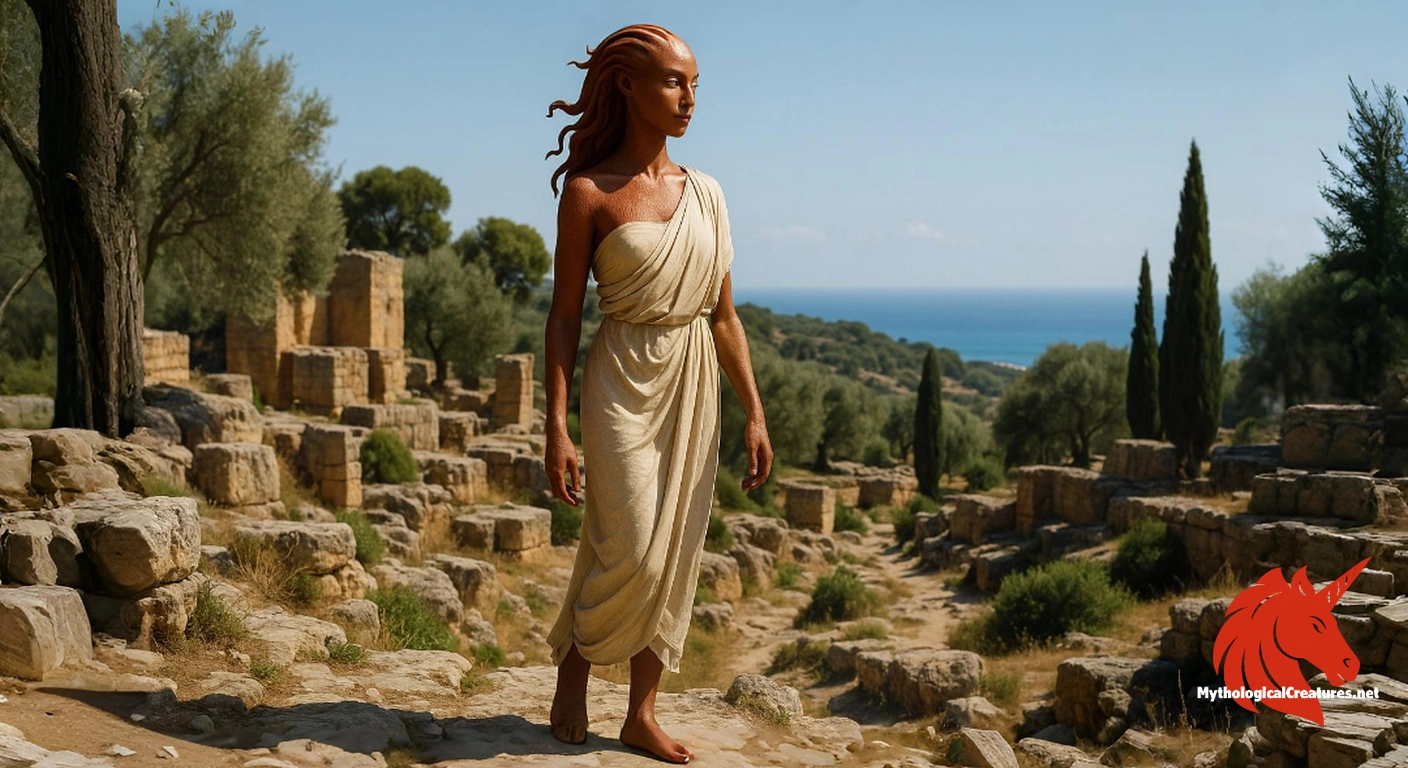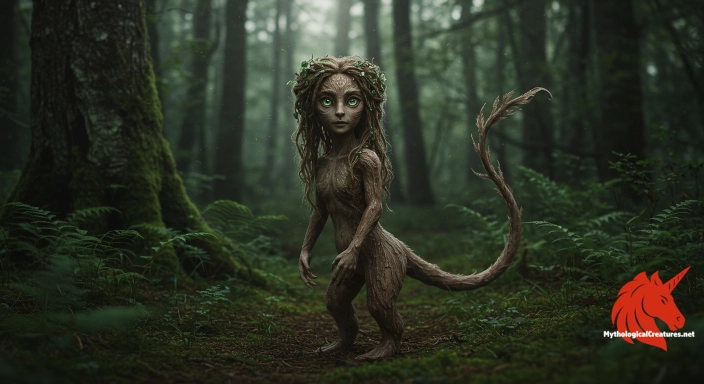Pareia: Pareia, also known as Paria, is a Parian nymph featured in Greek mythology.

Pareia
Pareia - Pareia is a minor mythological figure known for her role as the concubine of King Minos and as the mother of sons who were involved in the mythic narratives of Heracles.
Origins & First Encounters
Pareia emerges in the intricate world of Greek mythology as a figure of quiet yet enduring allure, whose origins are firmly rooted in the rich traditions of Paros. Her name, meaning 'reddish-brown snake', suggests a deep and mysterious connection to the natural world, echoing themes of both fertility and latent danger. As a Parian nymph, she embodies the untamed beauty of her island home, which was celebrated for its unique artistic and natural splendour in antiquity. Her narrative is further entwined with the majestic lore of Crete, having served as a concubine to the fabled King Minos. This union gave rise to a lineage that would later intersect tragically with the heroic exploits of Heracles. The scant early attestations hint at a character who symbolised the volatile marriage between beauty and peril, evoking the ambivalence of nature itself. Her story, though brief in ancient texts, resonates with the themes of transformation, divine seduction, and the inexorable passage of fate. The enduring presence of Pareia in myth offers a tantalising glimpse into the enigmatic depths of ancient religious and cultural symbolism.
Her existence, delicately interwoven with narratives of power, retribution and renewal, continues to captivate those who seek to understand the complex interplay between mortal lives and divine influence in classical lore.
Source Texts & Tale Variants
The fragments of Pareia’s legend survive in a mosaic of ancient mythological references and poetic allusions that have been handed down through generations. Texts from antiquity, though only offering brief glimpses, assert her identity as a Parian nymph and detail her role as the consort of King Minos within the expansive milieu of Cretan myth. Minor mythographers often mentioned her in passing, embedding her story within broader narratives of familial strife and divine retribution. These early accounts, sparse as they were, provided a framework in which her lineage and the tragic fate of her children could be later elaborated upon. Later compendiums and poetic adaptations sought to expand her role, sometimes weaving her character into the fabric of local religious practices and ceremonial lore. Not all versions converge on the same details, with some traditions elevating her status to that of a mysterious spirit intertwined with nature’s secrets. The diversity of her portrayal attests to the fluidity of myth, where regional storytelling enriches and transforms even the most marginal figures. Each retelling, whether in the form of a brief mythic note or more elaborate literary composition, contributes to an evolving dialogue about power, beauty and the perilous edge of divine favour.
This multiplicity of accounts encourages modern interpreters to excavate the nuanced layers of her character, offering fresh perspectives on a legend that straddles the line between myth and metaphor.
Form & Powers
Although direct physical descriptions of Pareia are sparse in surviving texts, imaginative tradition has endowed her with an ethereal grace characteristic of the nymphs. Artists and storytellers have portrayed her as possessing an almost otherworldly beauty, with delicate features that capture the dual essence of gentle allure and wild potency. It is often suggested that her skin held a subtle sun-kissed glow, reminiscent of the rugged landscapes of Paros, while hints of a serpentine essence were symbolically reflected in her eyes and contours. Her hair, imagined as flowing in shades of autumnal auburn, evoked the warm, earthy tones implied by her name. In some artistic renditions, she is depicted draped in garments that ripple like the sinuous movement of a snake, reinforcing the connection between her and the creature after which she is named. Delicate yet unmistakably powerful, her visage carries an enigmatic expression that seems to balance both seduction and caution. The rarity of detailed ancient descriptions has not prevented later portrayals from capturing her dual nature—a harmonious blend of fragility and latent strength. Over time, these collective images have solidified the perception of Pareia as a being whose physical embodiment reflects the mysterious beauty of the natural world.
The interplay of soft, flowing lines and underlying hints of reptilian grace in her appearance continues to intrigue and inspire modern interpretations of her myth.
Regional Faces
Regional renditions of Pareia’s story vary considerably, reflecting the distinctive cultural and environmental influences of both Paros and Crete. On Paros, local myth often casts her as an embodiment of the island’s raw and untamed beauty, elevating her to a symbolic role in local festivities and rites that celebrate nature’s bounty. In these accounts, she is sometimes revered almost as a guardian spirit, her presence intertwined with the island’s lush landscapes and maritime traditions. Meanwhile, in Cretan lore her narrative takes on a more intertwined role with the royal and divine elements of King Minos’ court, highlighting themes of power, legacy and inevitable tragedy. Some regional traditions accentuate her connection to the serpentine imagery implicit in her name, portraying her as both an enchanting benefactor and a subtle harbinger of change. These variations often extend to the ritual life of the communities, where celebrations mark not only the beauty of nature but also its unpredictable and transformative forces. Local storytelling has allowed Pareia’s myth to adapt over time, mirroring the evolving values and concerns of each society. As these adaptations spread across different regions, they collectively underscore the dynamic adaptability of myth, melding local colour with pan-Hellenic themes.
The regional diversity in the depictions of Pareia enriches her legacy, offering a tapestry of interpretations that continue to evolve with each retelling.
Cultural Parallels
Pareia’s myth resonates with comparable narratives across Greek and Mediterranean traditions, particularly in her blending of divine allure with elements rooted in nature’s raw power. Her role as a lesser-known consort of King Minos invites comparisons with figures like Pasiphaë, whose own mystique is entwined with themes of unconventional beauty and tragic destiny. Like other mythic characters whose attributes draw on serpentine symbolism—most notably the primordial Echidna—she embodies the paradox of attraction and underlying menace. This duality of nurturing grace coupled with the potential for sudden peril finds echoes in many ancient legends that articulate the ambivalence of nature itself. Comparative analysis reveals that figures such as Pareia often serve as metaphors for transition, fertility and the shadowed unpredictability of the natural world. In drawing parallels with similar deities and legendary entities, her story underscores a recurring motif in classical myth: the fragile line between beauty and danger. The intertextual dialogue that emerges through these comparisons illuminates shared cultural understandings of the divine feminine and the forces of nature. Ultimately, her tale occupies a unique niche that both aligns with and diverges from other mythological archetypes, enriching the broader tapestry of ancient narrative traditions.
This comparative perspective not only highlights Pareia’s distinctiveness but also emphasises how ancient myths continue to offer insights into the universal themes of transformation and duality.
Legacy & Modern Evolution
Through the passage of time, the figure of Pareia has transitioned from a fleeting mention in archaic texts to an emblem of perennial intrigue and reinterpretation. While her early presence in myth was modest, modern scholarship and creative endeavours have revitalised interest in her enigmatic persona. Contemporary artists and writers now often cast her as a symbol of nature’s elusive beauty, positioning her at the crossroads of mythology and modern ecological or feminist discourse. Her connection to the illustrious yet tumultuous realm of King Minos has invited renewed analysis of ancient gender dynamics and the interplay between mortal ambition and divine caprice. In academic circles, her story provides fertile ground for exploring the evolution of myth, illustrating how even minor figures can acquire multifaceted significance over time. The digital age has seen her reimagined in various media, from visual art to literature and interactive storytelling, where her image is adapted to reflect current sensibilities without sacrificing her mythic essence. Present-day reinterpretations tend to underscore her role as both muse and cautionary figure, embodying themes of vulnerability, resilience and the inexorable march of fate. Each modern retelling contributes to a legacy that is as dynamic as it is enduring, reaffirming the timeless nature of myth as a tool for understanding human experience. Furthermore, her subtle yet persistent influence is a testament to the continual reinvention of mythic symbolism in addressing the concerns and aspirations of successive generations.
In reimagining Pareia for a contemporary audience, creators not only pay homage to ancient traditions but also ensure that her story remains a vibrant part of the cultural and artistic discourse.
Interesting Fact
An interesting aspect of Pareia's myth is the duality in her identity, blending the serene qualities of a nymph with the enigmatic symbolism of a serpent.
Quick Creature Info
Origin:
Features:
Associations:
Our Mythic Legendary Rating:

Also Sometimes Known As:
Habitat:
Supernatural Powers:
Physical Attributes:
Abilities:
Behavior:
Lore:
References
Discover Another Mythical Legend You May Not Have Heard Of?
Uncover the mysteries of ancient folklore and expand your knowledge of legendary beings from cultures around the world.
Dare to Meet the Skogsrå....
Mythical Disclaimer: The images and data on this site are derived from various historical and literary sources, but we have found that many myths often have multiple versions and interpretations across references, sometimes contradictory. As a result, these creature depictions are artistic interpretations—imaginative blends of folklore, legend, and a dash of AI guesswork. Because creature descriptions vary widely, our illustrations and accompanying information represent our best effort to honor mythology while bridging creative gaps. Enjoy these interpretations—just remember, we've done our best to respect the stories and validate available data, but in the realm of mythology, details often shift, imagination leads the way, and nothing is ever set in stone!
Curated by the Mythological Creatures Team (rev. May 2025)
